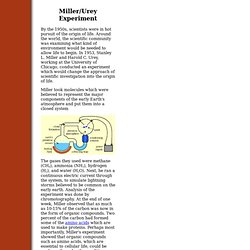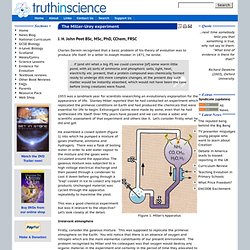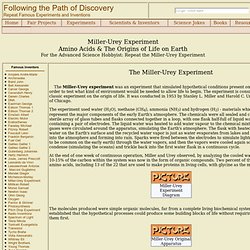

The Miller/Urey Experiment. By the 1950s, scientists were in hot pursuit of the origin of life.

Around the world, the scientific community was examining what kind of environment would be needed to allow life to begin. In 1953, Stanley L. Miller and Harold C. Urey, working at the University of Chicago, conducted an experiment which would change the approach of scientific investigation into the origin of life. Miller took molecules which were believed to represent the major components of the early Earth's atmosphere and put them into a closed system The gases they used were methane (CH4), ammonia (NH3), hydrogen (H2), and water (H2O). In 1961, Juan Oro found that amino acids could be made from hydrogen cyanide (HCN) and ammonia in an aqueous solution. These discoveries created a stir within the science community. There has been a recent wave of skepticism concerning Miller's experiment because it is now believed that the early earth's atmosphere did not contain predominantly reductant molecules.
The Miller-Urey experiment. Charles Darwin recognised that a basic problem of his theory of evolution was to produce life itself.

In a letter to Joseph Hooker in 1871, he wrote: … if (and oh! What a big if!) We could conceive [of] some warm little pond, with all sorts of ammonia and phosphoric salts, light, heat, electricity etc. present, that a protein compound was chemically formed ready to undergo still more complex changes, at the present day such matter would be instantly absorbed, which would not have been the case before living creatures were found. 1953 was a landmark year for scientists researching an evolutionary explanation for the appearance of life. Figure 1. He assembled a closed system (figure 1) into which he pumped a mixture of gases (methane, ammonia and hydrogen). This was a good chemical experiment but was it relevant to the objective?
Irrelevant atmosphere Firstly, consider the gaseous mixture. Consequently, evolutionary scientists have proposed that the early Earth had no elemental oxygen. Miller-Urey Experiment - Amino Acids & Origins of Life on Earth. The Miller-Urey Experiment The Miller-Urey experiment was an experiment that simulated hypothetical conditions present on the early Earth in order to test what kind of environment would be needed to allow life to begin.

The experiment is considered to be the classic experiment on the origin of life. It was conducted in 1953 by Stanley L. Miller and Harold C. Urey at the University of Chicago. The experiment used water (H2O), methane (CH4), ammonia (NH3) and hydrogen (H2) - materials which were believed to represent the major components of the early Earth's atmosphere. At the end of one week of continuous operation, Miller and Urey observed, by analyzing the cooled water, that as much as 10-15% of the carbon within the system was now in the form of organic compounds.
Other Experiments The Miller-Urey experiment inspired many experiments in a similar vein. Criticism of Miller-Urey Experiment There have been a number of objections to the implications derived from these experiments.